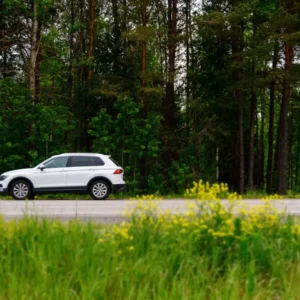All terrain vehicles are a popular pastime for many Ontarians, young and old. Although these rugged four-wheelers are not allowed on most roads, riders are required to have the same kind of basic insurance that you need to drive your car, or ride a motorcycle. How much you pay in premiums generally depends on the value of the ATV, and starts around $300 a year.
Welcome to the world of ATVing. Every year, tens of thousands of Ontarians take to an extensive system of trails that is maintained by hundreds of volunteers at one of the more than 40 local ATV clubs across the province. If you’re new to this motorsport, there are a few things you’ll need to know before you start getting muddy. For one thing, you’ll need insurance.
What insurance do I need to ride my ATV?
Similarly to other off-road vehicles like snowmobiles, you don’t need insurance if you’re riding on your own property. If you want to ride more broadly the insurance requirements are exactly the same as you would expect for a car, motorcycle or snowmobile.
Third-party liability
This is the coverage that protects you financially if you’re at fault for an accident and someone else gets hurt or their property gets damaged. Your policy pays for a lawyer if you need one, and also covers any money you are ordered to pay by a court. The minimum liability limit is $200,000, but we recommend $1 million at minimum. The difference in premiums is around $3 a month.
Accident benefits
Accident benefits coverage pays costs above and beyond what is covered by government health insurance if you’re injured in an accident. It covers treatments like physiotherapy, massage and chiropractic. It also pays your salary if you need to miss work due to your injuries. There are other benefits depending on the severity of the injuries.
Direct compensation – property damage (DCPD)
If someone else is responsible for an accident that damages your ATV, DCPD coverage pays for your repairs, or to replace your ATV. There is no deductible for a DCPD claim.
Uninsured automobile
This coverage exists to make sure that if you’re in a collision with someone else who is riding (or driving a car) without insurance, you still get whatever benefits you’d be entitled to through their liability coverage, if they had it. This coverage applies to a hit-and-run where you can’t identify the at-fault driver, but in that case it will only pay for injuries, not property damage.
Family protection
Uninsured automobile coverage (described above) only gives you access to a maximum of $200,000 if you or a family member are injured by an uninsured or unidentified motorist. That’s why we always include family protection coverage, which can give you access to $1 or $2 million (matching your liability limit). $200,000 may seem like a lot, but if one or more family members suffer a serious injury, costs can quickly add up.
Optional collision and comprehensive coverage
To make sure you’re covered for theft of or damage to your ATV, regardless of fault, you’ll need optional collision and comprehensive coverage. For a new ATV, these coverages will account for just under half your premium, but are well worth the money.
What’s the best way to save on my ATV premiums?
If you’re over 25 and have a clean driving and riding record, ATV insurance is generally quite affordable, even if you choose to insure your ATV separately from your home and your car. Still, there are a few things you can do to save more on your ATV premiums:
- Bundle – If you insure your home, car and ATV all with the same insurance company, you can usually save 10-25% on your ATV premium.
- Ride safely – Having a ticket or at-fault accident on your record can add 20% to your premium for the first ticket, and even more for subsequent infractions.
What else do I need before riding an ATV?
Other than insurance, you’ll need a few other essentials before you take your ATV out on the trails.
Licensing
These are the licensing requirements to ride an ATV in Ontario:
- If you’re 16 or older, you’ll need at least a G2 license to ride an ATV other than on your own property.
- If you’re between 12 and 16, you don’t need any license at all.
- If you’re under 12, you can’t get a license, and as per Ontario law you can only ride while under the “close supervision” of an adult.
Most insurers in Ontario won’t offer you insurance for a child under 12. Children between 12 and 16 can be included under their parents’ policy.
Registration
All ATVs in Ontario need to be registered with the Ministry of Transportation, and must have valid plates. Registration is a one-time expense of $38. You must be at least 16 years old.
Trail permits
Since ATVs are not road-legal, if you want to ride, you’ll need to become a member of your local ATV club to use the local trails. The Ontario Federation of ATV Clubs (OFATV) offers an umbrella membership ($150 a year) that includes the use of member club trails, however, not all clubs in Ontario are included. Weekly and daily passes are also available.
Additional requirements
By law, you can’t ride an ATV without an approved helmet. So make sure you have helmets that fit everyone in your family that intends to ride.
Besides a helmet, it’s a good idea to have other protective gear, including goggles, gloves, a long-sleeve shirt, long pants and closed-toe shoes. Some ATV trails have quite a bit of tree cover, and the trees aren’t always trimmed.
It’s not a legal requirement, but since you can’t ride your ATV on the road, you’ll need a trailer to get your ATV from your home to the nearest trail. (You’ll also need an endorsement on your auto policy to cover the trailer. Talk to your broker.)
Safety first
No special license is required to ride an ATV, but it’s always a good idea to get some training. The Canada Safety Council offers a 6-1/2 to 8 hour training program operated by CSC certified instructors. The curriculum offers a fun and structured way to learn basic ATV operation skills, focusing on learning about controls, reading terrain, climbing hills, and turning. A separate course is available for children under the age of 14 (with parent permission) and the ATV must be the proper side for the child as per ATV industry safety standards. For children between the ages of 6 and 11, the parent or legal guardian must be present at the training site. There is also the option of doing a 3-hour digital course with a follow-up booking with an instructor upon completion.
Ready to ride?
If you’re ready to go ATVing but are still looking for a great deal on ATV insurance, then our brokers are waiting for your call. We’ll walk you through everything you need to know, make sure you get the coverage you need, and get you quotes from some of the best insurers in the province.
Looking for ATV insurance?
Speak with a Mitch Insurance broker today to get a quote on Ontario ATV insurance.
Call now
1-800-731-2228







I just finance a side by-side and the bank won’t let them release it to me with out insurance it only going to be riding on private property and I didn’t have a driver license what do I do ?
Hi Chris,
Thank you for your question! Regardless of whether your side-by-side will be used exclusively on private property or not, the institution you are financing from will typically require insurance to protect their investment. This is an extremely common practice.
Not having a driver’s license can complicate things. A valid license is usually required for both insuring and operating an ATV or side-by-side, even on private property. You may want to consult with your provider or reach out to a broker to discuss possible exceptions or alternative solutions for acquiring your recent purchase.
A couple of questions on insurance.
I would only be driving my ATV on my private property. So I realize I don’t need insurance.
However, if I am transporting it on a trailer between my properties, is it covered by my vehicle insurance if there was an accident on the road?
Also, is it covered by my home or cottage insurance in the case of theft from one of those properties?
Thanks,
Hi Kris,
While you’re right that you don’t need insurance for driving your ATV on private property, when you’re transporting it on public roads (even in a trailer) it’s important to know that your car insurance won’t automatically cover the ATV itself. Only some auto policies do this, but in many cases you’ll need to add specific coverage to insure the ATV against physical damage during transit. We recommend talking to your broker about this!
ATVs are considered personal property, so technically your ATV may be covered for theft under your home or cottage policy. However, as ATVs are sometimes considered specialty items, you may need to talk with your broker about acquiring an endorsement to ensure these items are covered.
How old of an ATV are you able to insure? I have 30 and 31 year old ATVs and I’d like to take them trail riding but need insurance. My current provider won’t insure vehicles older than 20 years. Is this something you can do? I’d only insure one of them as the other will never leave my property.
Thanks
Hi Chris,
A lot of carriers have restrictions on age based on ATV CCs, so we understand your troubles with finding coverage for your older vehicles.
Here at Mitch, we work with a lot of different carriers – some of whom do offer coverage for older ATVs (with some restrictions). We recommend you give us a call at
1-800-731-2228 and one of our brokers will be sure to reach out and help you find a solution.
Thanks!